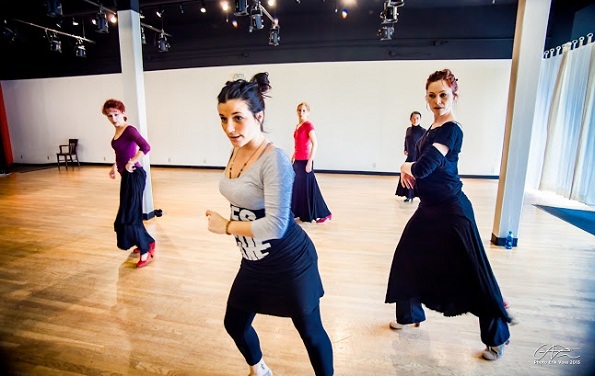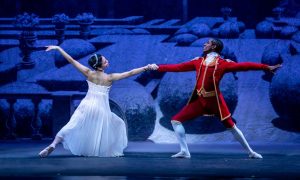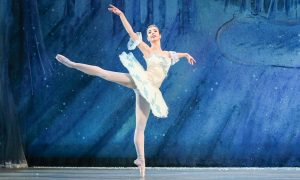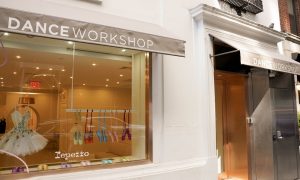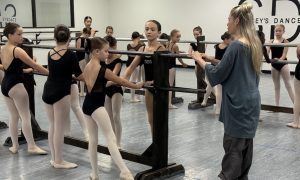By Julie Galle Baggentoss.
Flamenco dancers have a reputation for being fiery, dynamic and full of emotion, with percussive footwork juxtaposed against soft circling hands. Behind that strong image is a tradition of musical codes that puts dancers in the role of accompanist, part of a synergy within the group. Flamenco dancers listen carefully to live music to use their vocabulary to build the emotion expressed by a live singer. The code of nonverbal communication was the final lesson of a four-day workshop by La Compañía Manuel Liñán in March, while the company was in Atlanta to perform at the Rialto Center for the Arts.
Flamenco as we know it on theater stages and dance studios today originated nearly 150 years ago in southern Spain, called in Spanish “Andalucía.” It rose from a musical tradition, when gypsies extemporaneously belted out lines of poetry to express themselves in private gatherings. Flamenco dance came along later as an accompaniment to the live singing, as did the guitar. In the late 1800s, flamenco exploded into theater stages, and audiences around the world quickly embraced it. Today, based on its roots, flamenco dance is still created as an accompaniment to the singing, which can vary and sometimes completely change from one day to the next, depending on how the singer places emotive lines of poetry in standard melodies. In live performance art, this creates structured improvisation that is thrilling for many.
“Everyone has a role. In flamenco, no one is an island,” said Erica Poole, a flamenco student for six years and a participant from the singing and dance classes during the Liñán company workshop in Atlanta. “It requires synergy and attentiveness to one another.”
Using a mix of common and individual vocabulary, dancers react to ever-changing live music. The changes lead dancers to delay or arrive early at times with accents, such as splats of footwork, to enhance the expression of the song. And, in return, dancers influence the next lines of the song.
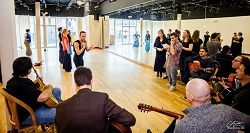 “The singer brings the flamenco song (the story), which is the basis of the flamenco work. The other disciplines create their works around their interpretation of it,” said Yolanda Bell, a flamenco dance student who attended the workshop in Atlanta.
“The singer brings the flamenco song (the story), which is the basis of the flamenco work. The other disciplines create their works around their interpretation of it,” said Yolanda Bell, a flamenco dance student who attended the workshop in Atlanta.
During the workshop, guitarists, singers, and dancers met separately in classes to learn new material “por tangos” (to the rhythm and melody of tangos, a form of song in flamenco.) Classes culminated with all disciplines in the room together executing the new work in its gestalt form, allowing students to experience the disciplines intertwined.
“I could find my movement and my body rhythm coming along with the singers, and with the guitarist, even though Manuel is a perfect teacher who makes you hear the music in his moves without any guitar or singer in the room,” said flamenco dancer Fani, who teaches and performs flamenco in Atlanta.
In the workshop’s final run of the piece, the singing began eight counts later than expected. Dancers and guitarists took that opportunity to listen and react accordingly to the unexpected change. According to the improvisational structure, they waited those eight counts to begin their next action for the group to continue.
“As a dancer, you really have to listen to the music and ‘cante’ (song) to be part of the unit, especially when you’re with your back towards the musicians and can’t see what’ they’re doing,” said Debbie Fung-A-Wing, who has been studying flamenco for several years in Atlanta.
Dancers’ skills as accompanists come from understanding the music, becoming musicians themselves as they percussively embody melody. Singers’ ability to lead dancers comes from understanding the needs of the dancers. Dance student Bell saw this when she attended singing classes, as well as dance classes during the workshop. She explained of her singing teacher Juan Debel, “When [a student] asked why the count seemed longer, he said that would accommodate the dancers. He also emphasized the ‘remates’ (strong endings to song verses) with ‘palmas’ (hand clapping) and where the entry of the dancers would be. Later, when we sang with everyone, it helped us to understand how all disciplines fit the flamenco work into one beautiful piece.”
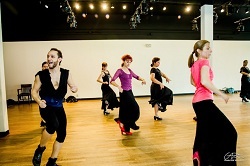 Bell attended the singing class to better understand the music that she accompanies as a dancer. “It is necessary that all of the disciplines understand how the others integrate into the flamenco work especially regarding the ‘compás’ (musical timing) to have that clean constant communication within flamenco,” said Bell.
Bell attended the singing class to better understand the music that she accompanies as a dancer. “It is necessary that all of the disciplines understand how the others integrate into the flamenco work especially regarding the ‘compás’ (musical timing) to have that clean constant communication within flamenco,” said Bell.
Putting the disciplines together reveals lessons that complement individual training and practice. “The singer can know when it is best for the dancer to ‘rematar’ (accent the end of the song verse or musical phrase), when to wait or when to listen for when the dancers will ‘rematar,’” said Liñán.
Just as dancers can create magic – that moment that makes people say, “flamenco is so passionate” – they can also kill the opportunity. “Flamenco is the only art where, in the learning process, everything can come crashing down if each component is not truly accompanying the other,” said Poole. “‘Baile, cante, and toque’ (dance, song, and guitar) all have to ride the same wave. If not, then any element could crash at any time losing momentum entirely for everyone.”
That responsibility to one another is part of the communal spirit of flamenco that inspires moments of rapture for witnesses, as well as the artists in action. Being able to work together live and in the moment is a goal for many who participated in classes in Atlanta in March.
“They have the material. Now they have to practice it,” said Liñán. “They have to practice a lot, many hours,” added guitarist Víctor Márquez “Tomate.” Singer Juan Debel explained, “When they dedicate much time to practice, they are able to come together. We taught them material to complement each other. Now, they practice on their own and then come back together, they will improve.”
And so it goes that flamenco dancers and the musicians whom they accompany work for years on their own to develop technique, repertoire and an ear for the music so that they can be great team members of a ‘cuadro.’ All the time, they must also hone their skills to listen, watch and react in the group setting. In time all of the gear turning that must take place inside the mind of the flamenco dancer, becomes second nature. Thinking gives way to feeling, as they say in flamenco.
Dancer Poole said of accompanying musicians during the Atlanta workshop, “There was no thought as to whether I had to wait two beats because I could feel where I was supposed to dance with the ‘cante’ (song), plus I recognized when I was specifically calling for more cante.”
Some say it is when the dancer feels, as Poole explains, that she is able to fully communicate to witnesses the singer’s emotion that she is embodying. That connection to the music helps create the moments when flamenco hits witnesses, sends goose bumps across the skin and coaxes cheers of “¡Olé!” The strong flamenco dancer often gets the credit for the upwelling of emotion, when unbeknown to many, she was led there by her singer.
Photos: Dancers participate in a four-day workshop with La Compañía Manuel Liñán in Atlanta. Photos by Erik Voss.


